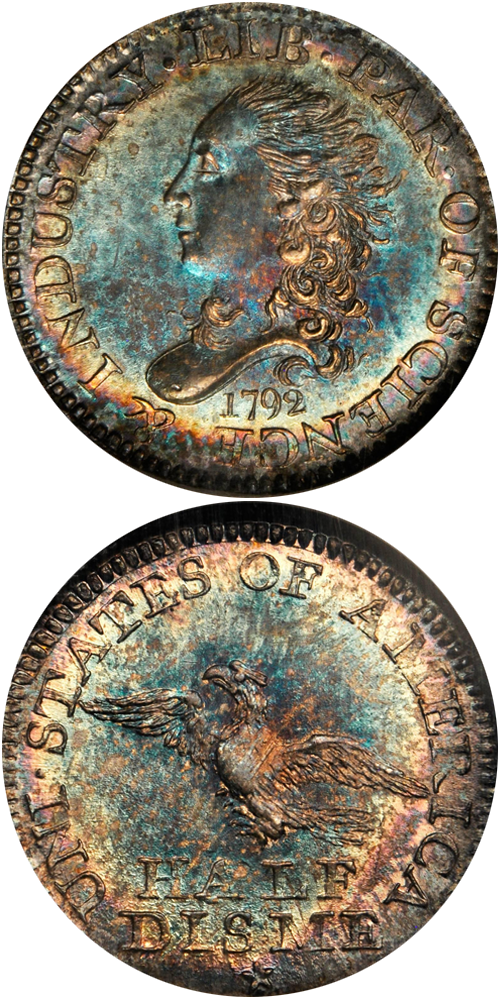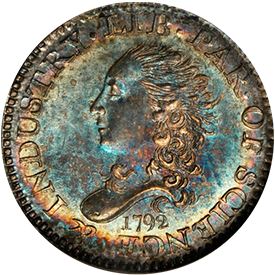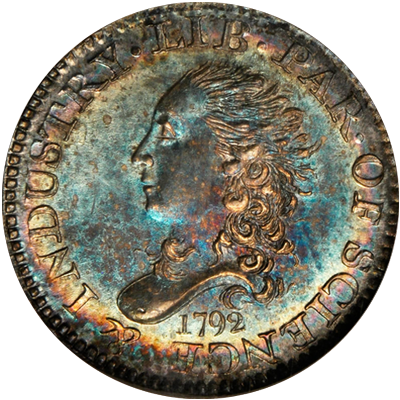Designed by: Robert Birch and Joseph Wright
Issue Dates: 1792
Composition: 89.24% silver, 10.76% copper
Diameter: 17.5 mm
Weight: 1.35 grams (20.83 grains)
Edge: Reeded
Business Strike Mintage: est. 1,500-2,500
Proof Mintage: None
Over the past decade or so, the 1792 Half Disme (pronounced “deem” has been the subject of considerable debate among numismatic scholars. Some contend it is a pattern issue, while other argue that it is the first “regular issue” coin struck by the United States. Both sides of this issue have some merit.
In favor of it being considered a pattern are the following points:
1. Its design is similar the other pattern issues of 1792, such as the Silver Center Cent, the Birch Cent and the Disme.
2. It was struck privately, outside the U.S. Mint (which had not yet begun operations) by John Harper in his basement, in mid-July, 1792.
3. The Guidebook of U.S. Coins (the Redbook) still lists it as a pattern.
Those who argue for “regular issue” status cite the following:
1. Some 1,500 (or more) pieces were struck, far more than any typical pattern.
2. The coins circulated, and many are found today in lower grades.
3. George Washington, in an address to the House of Representative on November 6, 1792, said “There has been a small beginning in the coinage of half dimes, the want of small coins in circulation calling the first attention to them.”
While this topic will continue to be a matter of debate, the closest parallel we can draw would be the 1856 Flying eagle cent. It is estimated that between 1,000 and 1,500 pieces were struck, and some entered circulation. Does that make it a regular issue or was it a pattern? There is no absolutely correct answer.
The most authoritative article providing the latest research into this topic was published in July 2020 by Pete Smith, Joel Orosz and Leonard Augsburger and is entitled “A More Accurate History of the 1792 Half Disme” and can be found on the ANA’s website here: https://blog.money.org/coin-collecting/history-of-the-1792-disme
Further Reading
Half dimes or silver five-cent pieces were regularly coined from 1794 through 1873. Prefacing the series is one of the most interesting and romantic of all American coins: the 1792 half disme spelled with an "s" in the middle of the word and pronounced “deem”.
In 1792 President George Washington in his annual address specifically mentioned the 1792 half disme as being the first product of the newly established Philadelphia Mint. Legend has it that the silver to coin the approximately 1,500 pieces was personally provided by President Washington in order to expedite production of the coins but proof of this is lacking.
The design of the 1792 half disme closely follows the famous Birch pattern cents of the same year. The obverse features a head of Miss Liberty, modeled, as some suggest, after Martha Washington (but the attribution is doubtful), surrounded by the inscription LIB. PAR. OF SCIENCE & INDUSTRY. The reverse shows a bird (an eagle?) in flight, with inscription surrounding.
Although officially intended as a pattern issue, 1792 half dismes were placed into circulation as a means of exchange. This was done at the time of issue, with George Washington noting that they were struck to fill a demand for them in the channels of commerce. So, it is appropriate to list the 1792 half disme as the first circulating coin in the half dime series. Whether it is a regular issue or whether it should simply be construed as a pattern is a subject of debate. From a strictly legal viewpoint it is a pattern. However, as nearly all of the mintage was actually used in circulation, a case can be made that it should be included as part of the general half dime series. Either way, the piece is mentioned here because of its interesting nature. However, it is appropriate to note that the majority of half dime collectors as well as those forming type sets have not included this particular piece as part of the regular series.
Approximately 100 to 200 specimens of this coin survive today. Nearly all of them show extensive wear, with Good to Fine being representative grades. A handful of Uncirculated pieces have been certified, with even a few in gem condition.








